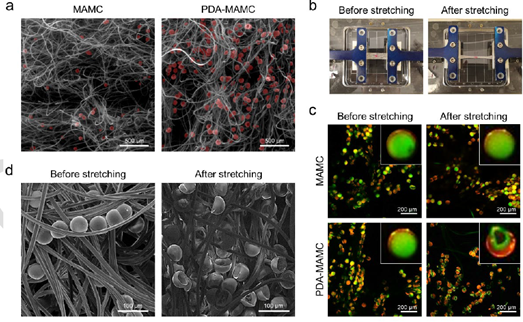An adhesive drug-loaded microcapsule which releases therapeutic cargo upon mechanical stretching.
Problem:
Medicated dressings can improve healing of open wounds and improve pain management in patients. However, drug-coated bandages lack stimuli-response release mechanisms, so therapeutics are not released in a controlled and sustained manner. Poor control of cargo release in current wound-healing membranes generates large fluctuations in dosing, whereas controlled release mechanisms create relatively constant drug concentrations at the wound site. Stable drug-release maintains therapeutic dose over the entire duration of wound-healing and promotes better antimicrobial and pain-killing effects.
Solution:
The technology is mechanically-activated microcapsules (MAMCs) which can be loaded with therapeutic cargo. The MAMCs are coated in an adhesive polymer so they can be bonded to fabrics, membranes, or bandages. Once MAMC-coated dressings are applied to a wound, stretching of the material due to bodily movement induces tensile strain which releases drug from capsules at the wound site. The mechano-responsive microcapsules can be loaded with any combination of antibiotics, anti-inflammatory medication and painkillers depending on the medical need.
Technology:
Uniform drug-loaded poly(lactic-co-glycolide) acid microcapsules are made using a capillary microfluidic device. Strain-responsive polymeric capsules are coated with poly-dopamine which serves as an adhesive for coating MAMCs onto wound-healing fabrics and membranes. When mechanical strain is applied to MAMC-coated materials, therapeutic molecules are released form microcapsules due to Poisson-ratio squeezing, controlling the release of drugs.
Advantages:
- Adhesive coating prevents detachment of drug-loaded microcapsules from wound dressings
- Significant drug release from adhesive microcapsules at 50% stretch strain

(a) Microscopy images of gauze embedded with MAMCs. The red circles indicate microcapsules. (b) Photographs of the MAMC-embedded gauze membrane before and after stretching using a custom micromechanical device. (c) Confocal images of the MAMCs containing bovine serum albumin (green) with labeled microcapsules (red). (d) Microscopy images of the adhesive MAMCs in the gauze before and after stretching.
Case ID:
20-9300-tpNCS
Web Published:
4/8/2024
Patent Information:
| App Type |
Country |
Serial No. |
Patent No. |
File Date |
Issued Date |
Expire Date |